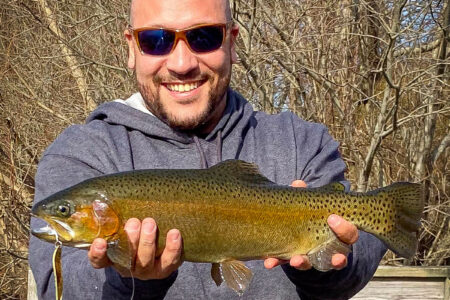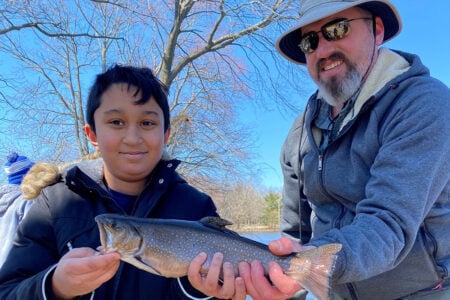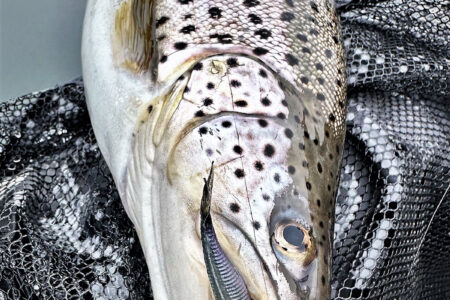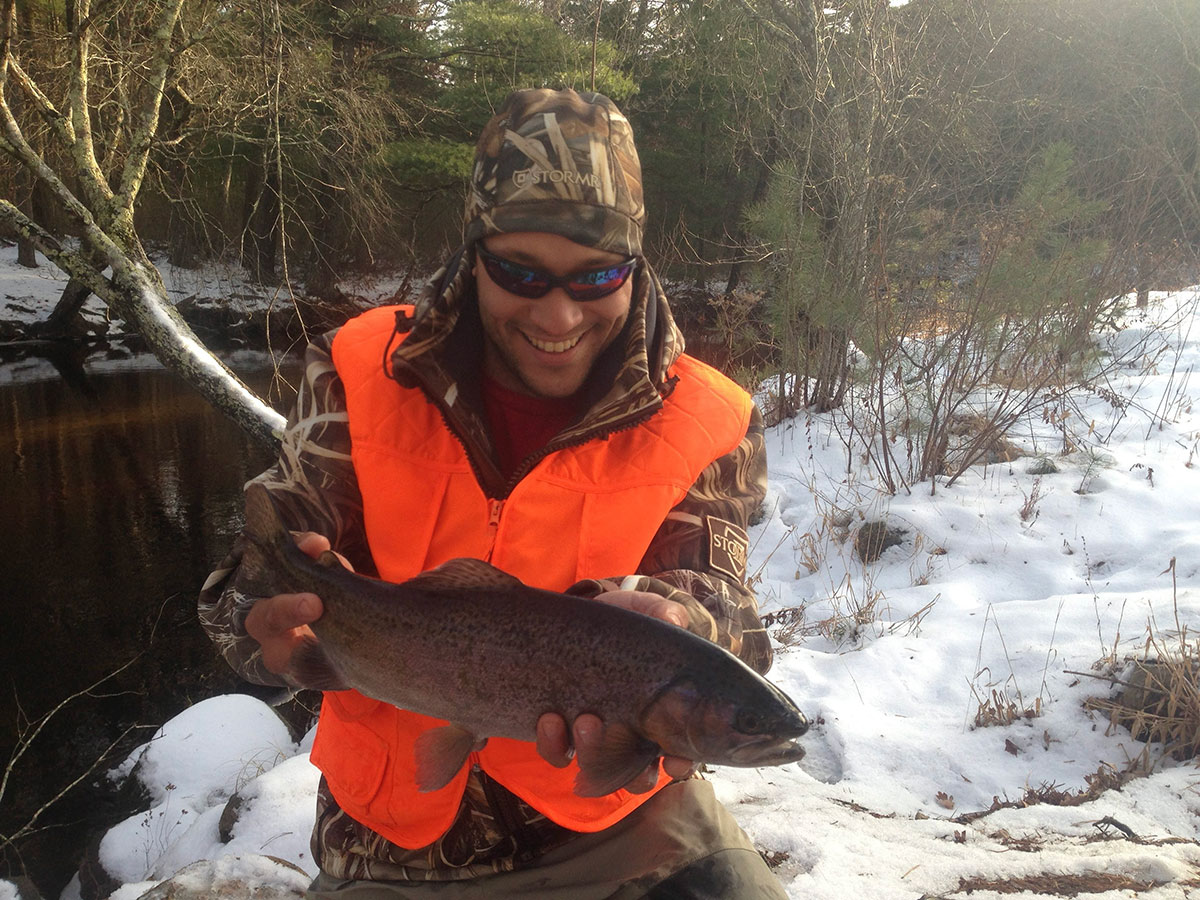
The New England winter doesn’t have to be something you wish would go by quick!
I’d slept in a little later than normal for a fishing trip, however it wouldn’t matter today. Just as predicted, the temperature was still climbing and a mix of light snow and drizzle was falling as the barometric pressure continued to plunge. My first cast had (intentionally) come back without a sniff. I’m not really superstitious except for when I’m fishing and I’d fallen victim to the “curse of the first cast” plenty of times before.
My second cast was fired across the river just ahead of an undercut bank. The first couple cranks brought my jerkbait to “target depth”. I allowed the lure to suspend as the current swept it past a deeper pocket, then began a set of erratic twitches and pauses. Just as I’d initiated my second set, the lure came to a dead stop, the healthy rainbow turned sideways and took off downriver. After release, I hiked further upstream catching several more trout along the way, and never encountering another human being.
Winter Woes?
While I do miss the porpoising hardtails and blitzing bass, I look forward to winter trout fishing. I’d go nuts if I wasn’t able to fish all year; and this is a great way to get out and catch fish when saltwater options are few and far between. Add the holiday season hangover into the mix (I’m a bartender) and you can probably understand why I’ve developed a passion for getting out in the winter.
Southern New England has a plethora of great trout rivers; the Farmington, Deerfield, Swift, and Wood Rivers (along with their tributaries), to name just a few. There are plenty of opportunities to extend your season. They all have their unique intricacies, but most of these tactics will work with a little adaptation.
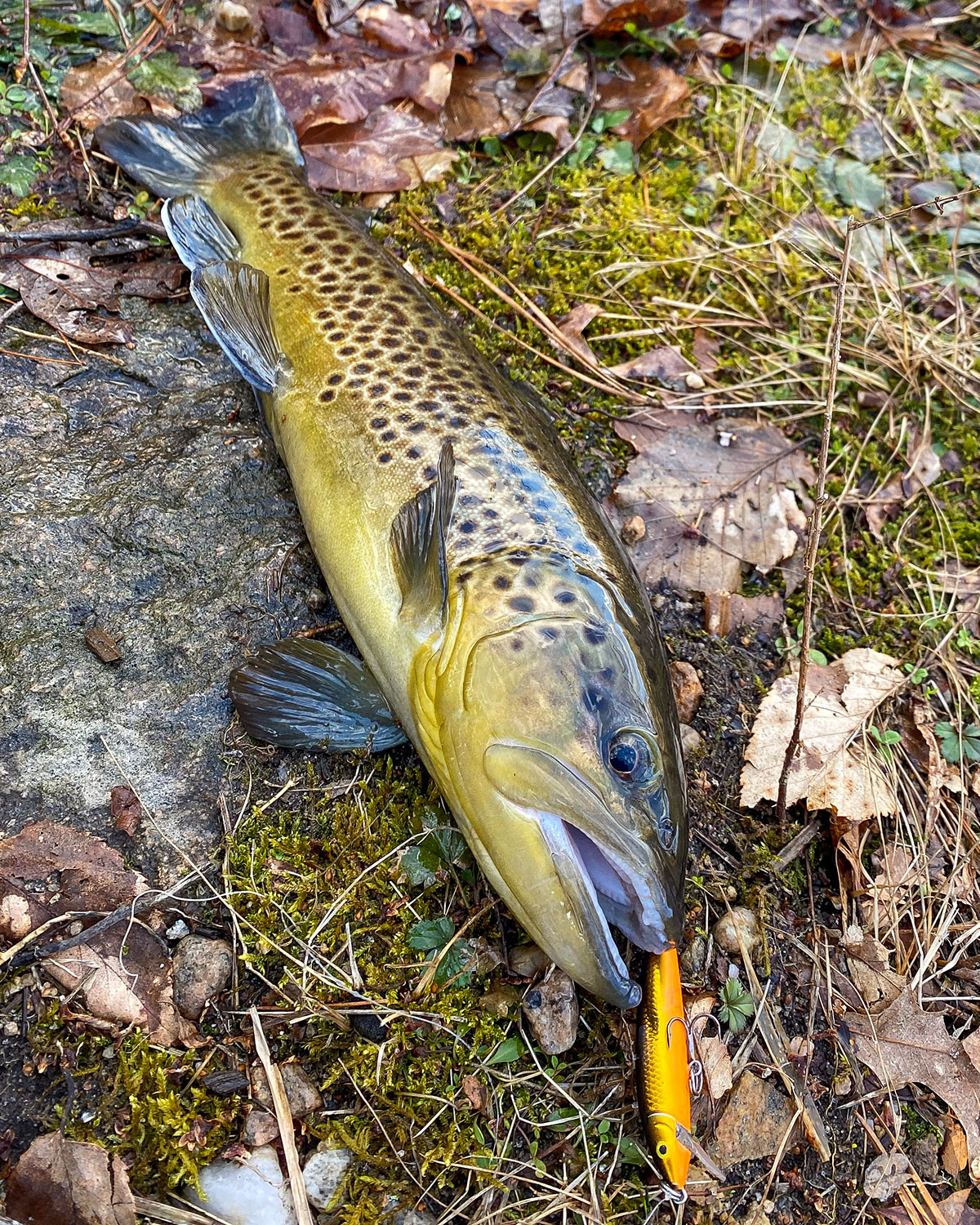
Game Plan
I’ve done best on days with cloud cover and ideally some precipitation, and I’ll try to go on one of the warmer days if possible. Not only do the fish seem to respond to a temperature increase, it’s much more comfortable for the angler, too. I also keep an eye on the barometer, a sudden drop in pressure will often put the fish on the feed. Those blustery bluebird days tend to be the least productive, but if that’s the only day I’ve got, I’ll try and fish early in the morning or later in the afternoon.
Picking a starting point is like any other form of fishing, it requires a little homework. Living in southwestern Rhode Island, I tend to fish the Wood River or the Moosup, and their many tributaries. Years of fishing these areas taught me that having a game plan goes a long way. I often do my initial research with Google Maps or onX; the latter also helps to avoid accidental trespassing.
After that, it’s time to go old school. Do yourself a favor and pick up some trail maps to keep in your pack or pocket, (for my local areas I like the ones from Great Swamp Press, unfortunately it seems they’re out of print). Some of the bigger pools will actually show up on these, but the main advantage is being able to see a large chunk of the river system at a glance, this can save from making a fruitless hike or ending up in a swamp! Plus they’re really helpful if you lose phone service.
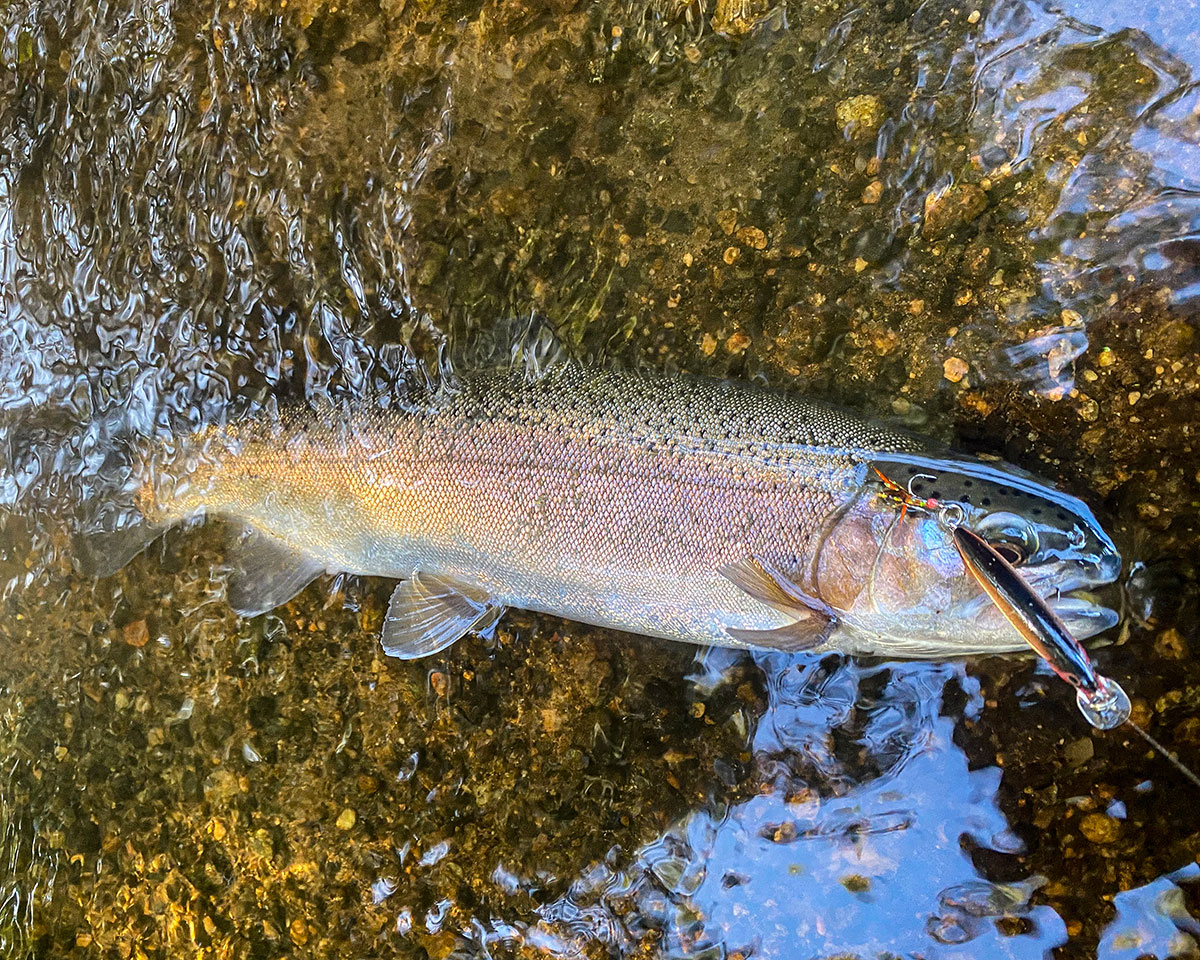
Approach From The Rear
I always prefer to fish my way “up” a river or stream if possible. I stay out of the water as much as I can and walk along the banks. Be stealthy, as any trout that’s made it through the opening day onslaught and lived in the wild for a few months has become very wary of threats from above. If you must get into the water, (sometimes it’s inevitable) wade slowly upriver. Creeping from behind is less likely to cause fish to bolt downstream and into the next zip code; ideally you’ll only bump them forward to the next spot where they feel safe.
In moving water fish will sit with their heads facing into the current. Walk slowly, stop every so often and take a look around for a spot that looks fishy. Since most of the Wood is pretty clean and shallow, I sometimes see trout hanging just off a current seam or in an eddy. Be aware that they might have also seen you and approach with caution. Set up the cast and make it count. I like to land my lure a couple yards upstream and sweep it past the fish’s nose by a foot or two. Putting a cast right on their heads often spooks them with all but the lightest lures. That being said you can sometimes get away with this in the rain. Use this tactic in spots that look fishy but you don’t see a fish, trout wouldn’t last long in the wild if they were always visible. A pool of deeper, darker, slower moving water is prime trout habitat, as is an undercut bank.
While in the summer heat you might only find trout in those deeper thermal refuges. I have found in cooler months they’ll be more apt to spread out. When you see a riffle a foot or two deep where you can’t see the bottom, give that a shot. A few softball-sized rocks on the streambed can provide enough of a break for a trout to set up and wait for food or take a rest. A large boulder or downed tree (ideally with some deeper water) is even better. Sometimes several fish will stage on the down-current side waiting to streak out and ambush prey. In slower water I often find hanging a plug like a jerkbait, countdown, or streamer in the flow and slowly pulling it up-current will entice a hit. In faster water, I’ll work the opposite direction, casting upstream then running the lure at a 45-degree angle or so towards myself, using a more aggressive, erratic approach.
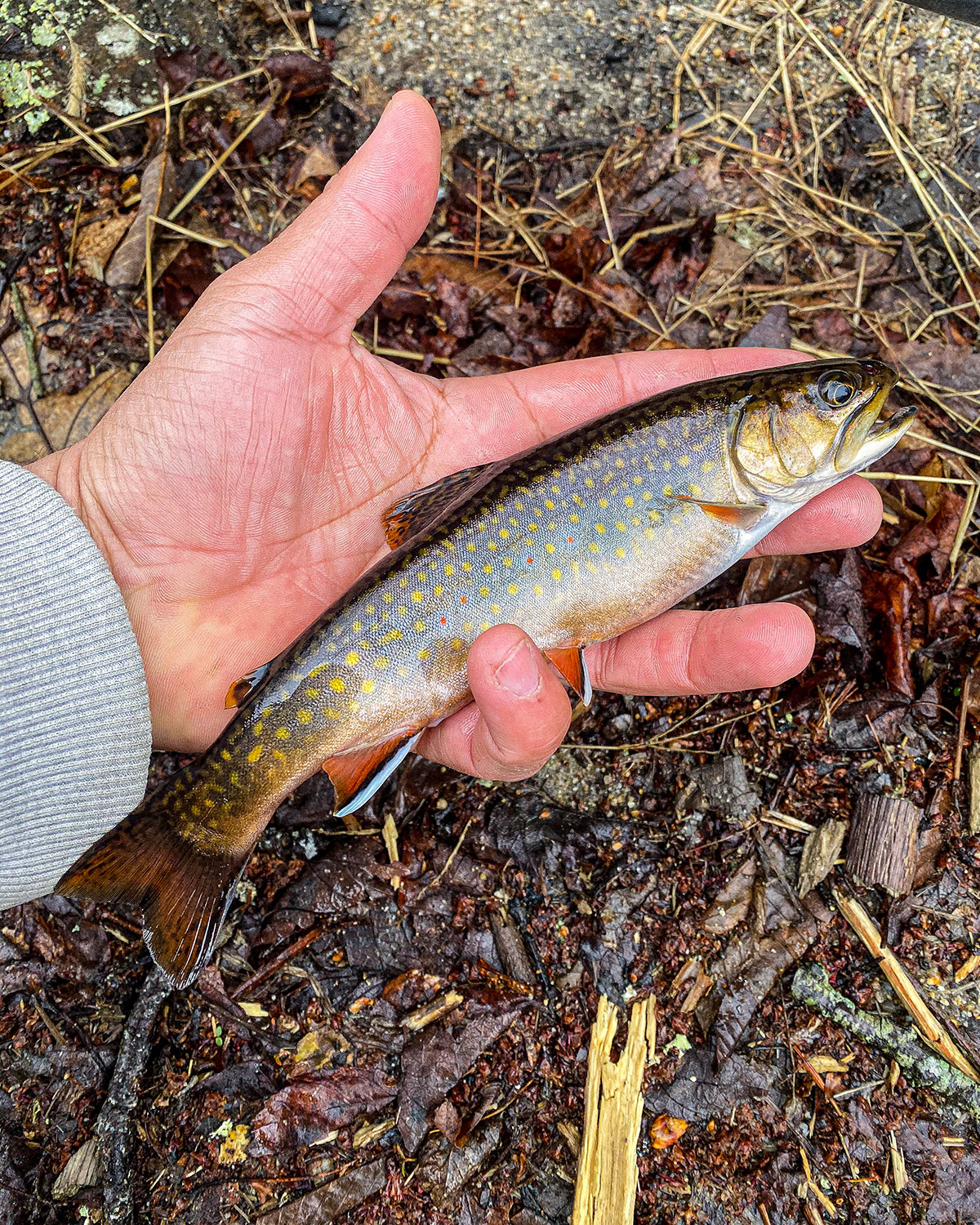
Backpacking Light
I can fit pretty much everything I’ll need (including duplicates of some favorites) in a small double-sided Plano 3449-22 box. This box lives in the front pocket of an Igloo cooler backpack along with my leader spools, lunch and a couple bottles of water. My everyday pliers/cutters stay on a lanyard on my waders. I keep a set of small forceps in the bag as well. The Plano carries five basic categories of lures: jerkbaits, spoons, streamers, jigs, and spinners.
For jerkbaits my standards are the Rapala Husky Jerk (size HJ6) and the X-Rap in sizes XR05 and XR04. Blue/silver is my go to color, but gold, silver, olive green and Tennessee Shiner are all staples. Firetiger and perch colors are also must-haves for trout. Also, sometimes white is a key color, particularly with the sinking models. Both lures have their days, but the X-Rap fishes better in heavy current and is available in smaller sizes. I always carry a few CD05 Countdowns in perch and firetiger as well.
My favorite spoon for streams is the Mooslook Wobbler. It’s light for its size, offering an advantage in shallow water. You can fish it with a steady retrieve in slower sections of the river, or cast it up-river and flutter it down and across the current. The Acme Phoebe is the other option, but it’s best for deeper pools and heavier flows. I don’t fish spinners all that often but they’re so ‘classic’ that I always have them on hand. The traditional Mepps Aglia or Joe’s Flies are typically reserved for lakes and ponds, but will definitely catch in rivers. My personal favorite is the Hi-Country Flies Pistol Pete. It’s technically more of a streamer fly with a prop, but it draws a lot of attention and – I’d say – it qualifies as a spinner.
Flies aren’t just for the buggy whip crowd. Streamers have saved many tough days on the river for me. I always have several Empie’s Deadly Shiners in my box. The action on this streamer is amazing and it’s easy to throw on an ultralight rod and it seems to put a spell of finicky fish. Sometimes a small split shot sinker a foot or two above the fly (think of a micro Carolina Rig) is required to get down into deeper spots. Another fly in my starting rotation is the Spawn Flyfish “Dropper”. It’s absolutely deadly on native brook trout, just make sure you crush the barb if you’re targeting these gems, and it’s never a bad idea to have a few wooly buggers as well.
I love the versatility of tube jigs like the Berkley Atomic Tube Jig. It can be fished fast in heavy current but if needed you can always slow the presentation down. It can also be hopped across the bottom and is still effective in cold weather with long pauses. I keep a few small paddle tails like the Berkley Power Swimmer on light jigheads ready to go as well.
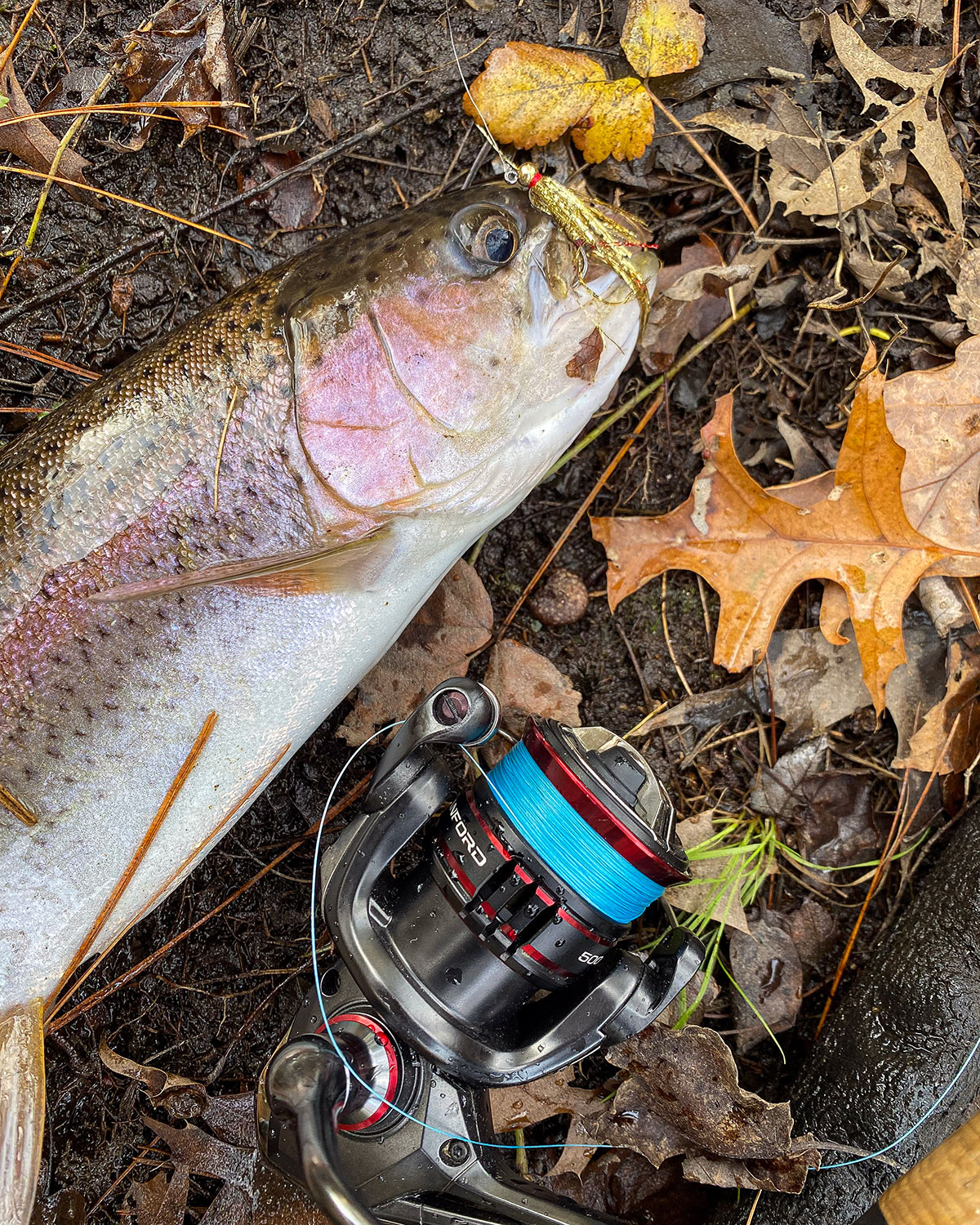
Stick For The Sticks
When it comes to the rod and reel you definitely don’t have to break the bank, but I subscribe to the ‘buy once, cry once’ mantra. I fish a 5-1/2-foot GLoomis TRS 621 Fast Action paired with a Shimano Stradic Ci4 500; with that said, any 5- to 6-foot ultra-light setup will get the job done, just make sure it’s rated to throw the lightest lures possible. My reel is spooled with 10-pound Power Pro Super Slick V2. Yes, that’s overkill, but with such thin diameter and low memory (essential in the cold), it’s been phenomenal. I tie a 6-foot leader of 6-pound fluoro to my mainline with a uni-to-uni, I use Seaguar blue label. I don’t use any snaps or swivels, I always tie direct to the lure with an improved clinch knot. Once I’ve retied a few times and shortened the leader to about four feet I’ll change out my leader.
| SWEATER WEATHER |
| It goes without saying that you’ll want to dress for the weather, but a few other items you should not be without include a pair of polarized sunglasses with amber lenses, these are essential for spotting fish in pools and riffles. Also make sure to check local hunting regs because you may be required to wear flame orange for your safety. Lastly, bring a knife and keep it in an accessible spot in case you wind up ensnared in a briar patch! |
This setup is a dream to use, light and sensitive. It’s capable of subduing the biggest browns I’ve found hiding near thick cover but also makes catching wild brookies fun. Just as important, it’s accurate. When fishing tight quarters in moving water lure placement is key. The only real downside is the softness can sometimes hamper hooksets in between “twitch” and “pause”. Whatever rod and reel you choose will depend on how you like to fish and what you’d like to spend, I recommend shorter length and lighter action as the former will make it much easier to maneuver through the backwoods where long casts aren’t required, and the latter is ideal for slinging miniscule lures.
So if you’re feeling the itch, and you’re kind of “over” the holiday spirit, grab your gear and get out there. You might have one of the best days of your season, during a time when most anglers are in hibernation.

